How To Make Sourdough Starter
This post may contain affiliate links. Read our disclosure policy.
If you’ve ever wondered how to make sourdough starter without yeast, this is your complete guide! Traditional 7 day sourdough starter with perfect results, every time. It’s an easy recipe that takes just 5 minutes a day.
What do you do when your spring isn’t turning out anything like what you thought it would be? You bake bread. Because the aroma of freshly baked bread brightens even the longest, darkest days.
For the past two years I’ve been tackling two types of sourdough. One is sweet, the Amish sourdough starter recipe needed for this Friendship Bread. The other is a classic sourdough that bakes up beautiful loaves of sourdough bread, sourdough biscuits, waffles, sourdough pancakes and even a chocolate cake with sourdough.
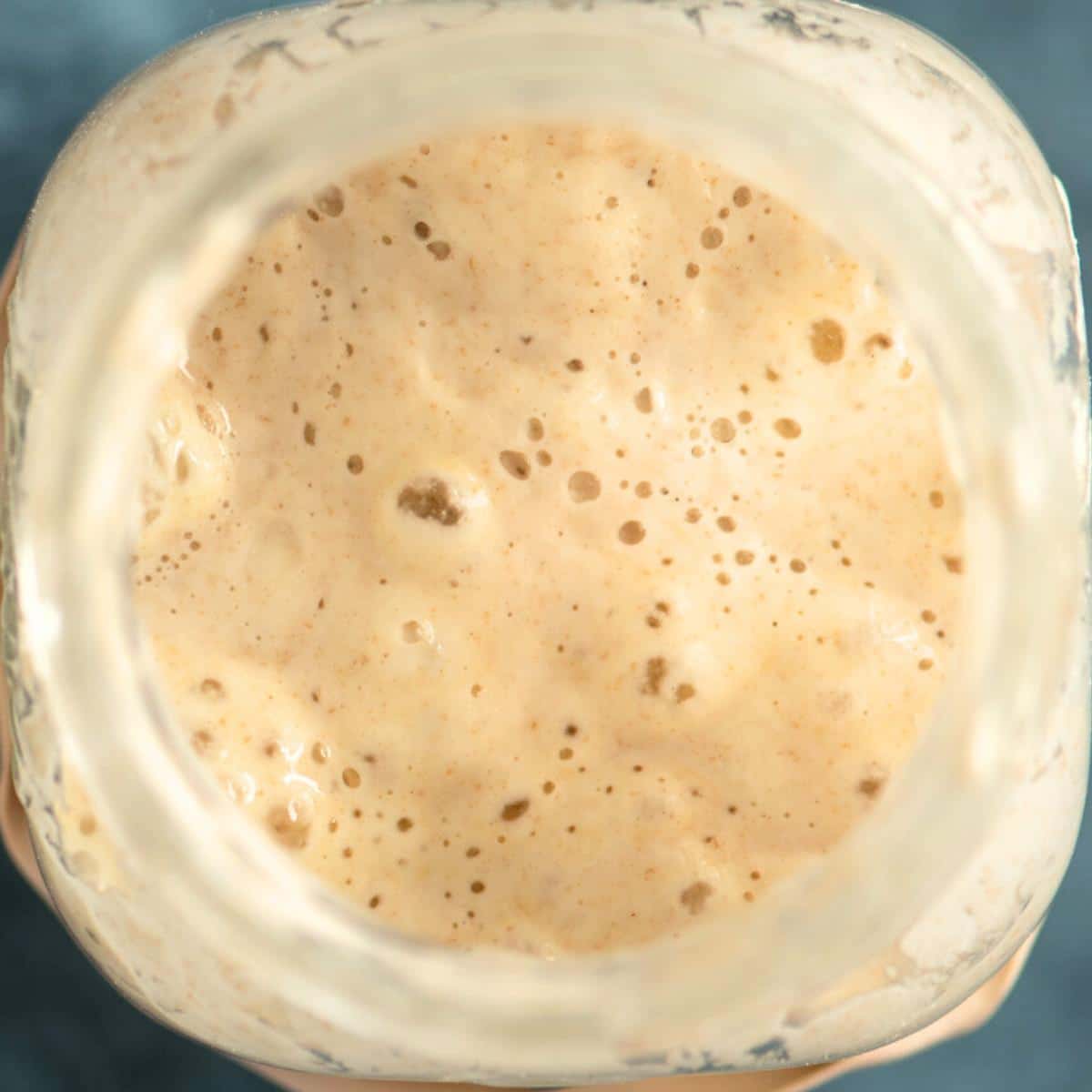
Sourdough starter is a “wild yeast” that bakers use in in place of commercial yeast. Throughout this sourdough starter making process below, flour and water will go through a fermentation process and grow naturally occurring bacteria and yeast that will give breads a beautiful rise.
Does sourdough really take a week?
Plan a week to get this sourdough active enough to rise a loaf of bread. Yes…a week seems like a long time, but it’s easy because it takes about 5 minutes a day. There are sourdough starter recipes with yeast if you want a “lazy” sourdough.
Sourdough starter without yeast is 100% worth it. When you make your own sourdough starter, it’s so rewarding!
Two Tools Needed
There are two tools needed for the best results:
- kitchen scale – Although you can measure by volume, for the best consistent results, investing in a kitchen scale. It’s worth it and will give a consistent hydration level.
- sourdough jar – Glass jars hold sourdough beautifully. I love that they are glass so you can see the fermentation. They give lots of room for the starter to double. And they seal nicely when you need a break from baking bread.
Did you know?
Don’t store your sourdough starter in a metal container. Not all metal is created equally and acids react to metals. Use glass for the safest results.
Two Key Ingredients
It’s important to use unbleached flour and non-chlorinated water for sourdough starter.
- Non-Chlorinated Water. Use filtered water since chlorine in tap water can kill the yeast as it tries to grow. Keep bottled water on hand.
- Unbleached Flour. Bleached flour does not have as much natural yeast as unbleached flour does. I’ve had the most success with Meijer store brand unbleached flour. Please note that the first day you’ll need unbleached whole wheat flour, but the rest of the days use unbleached white flour. King Arthur unbleached flour is another good option.
How To Make Sourdough Starter
We’re going to talk about the sourdough process in days. Plan for 7 days to work with the sourdough. It won’t take long at all each day…less than 5 minutes after you get it going!
Here are our step-by-step instructions:
DAY 1:
- Start with a clean glass jar, such as a pint size mason jar or weck jar. It should able to hold about 2 cups so that it can handle the rise of the starter.
- Place the jar on the kitchen scale. Turn the scale on and make sure it is reading 0 grams. If it isn’t, press the “tare” button to get the display to read zero.
- Add 60 grams of unbleached whole wheat flour and 60 grams of warm, non-chlorinated water. The mixture will be very, very think. It won’t be impressive at all to start. But just wait. 🙂
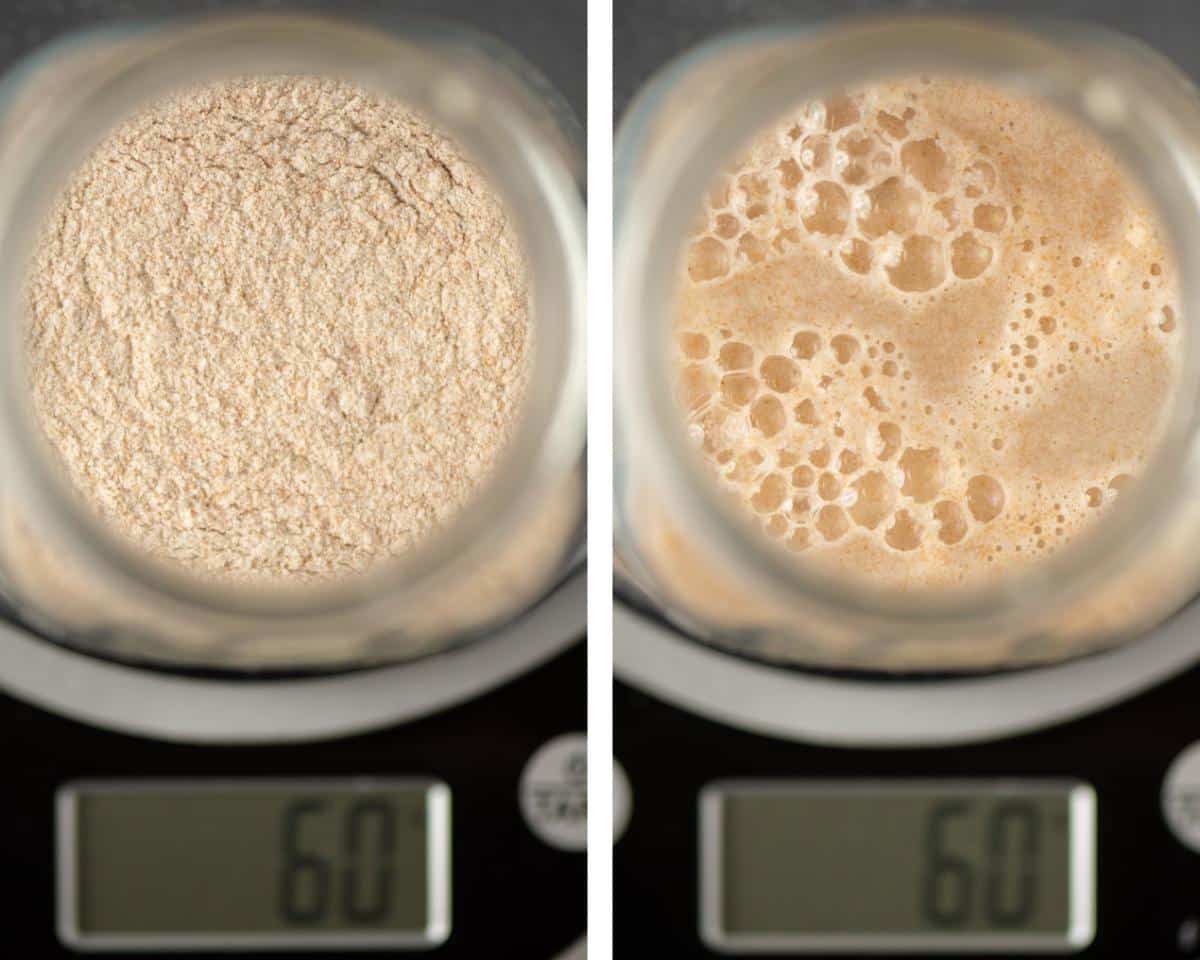
- Cover the jar loosely with plastic wrap and let it sit on the kitchen counter at room temperature, or in a slightly warm place, rather than cool.
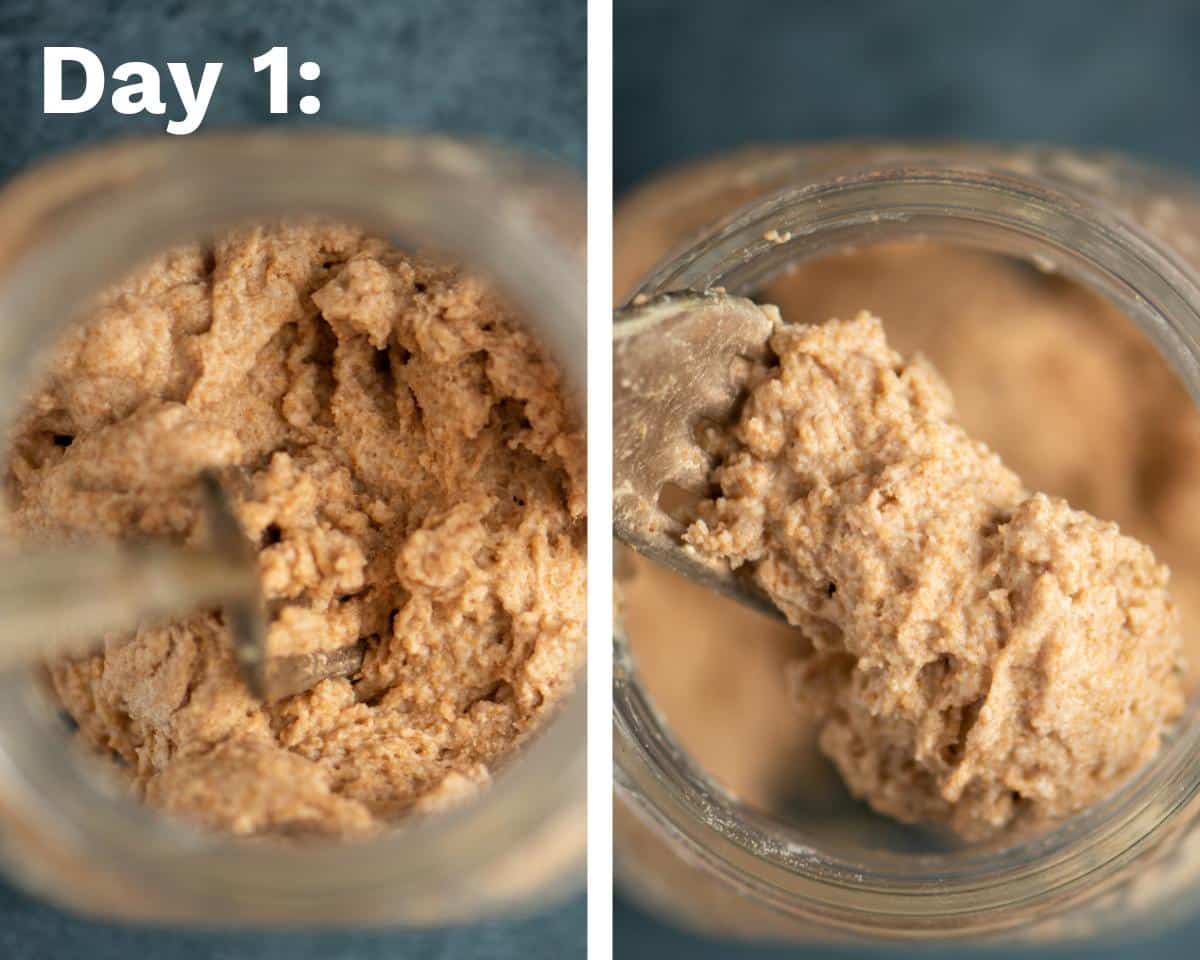
DAY 2:
- Check the starter. You’re looking for bubbles to form. If you don’t see any, it is ok because they come and go fairly quickly.
- Don’t mix it. Just check it, then let it sit again for another 24 hours.
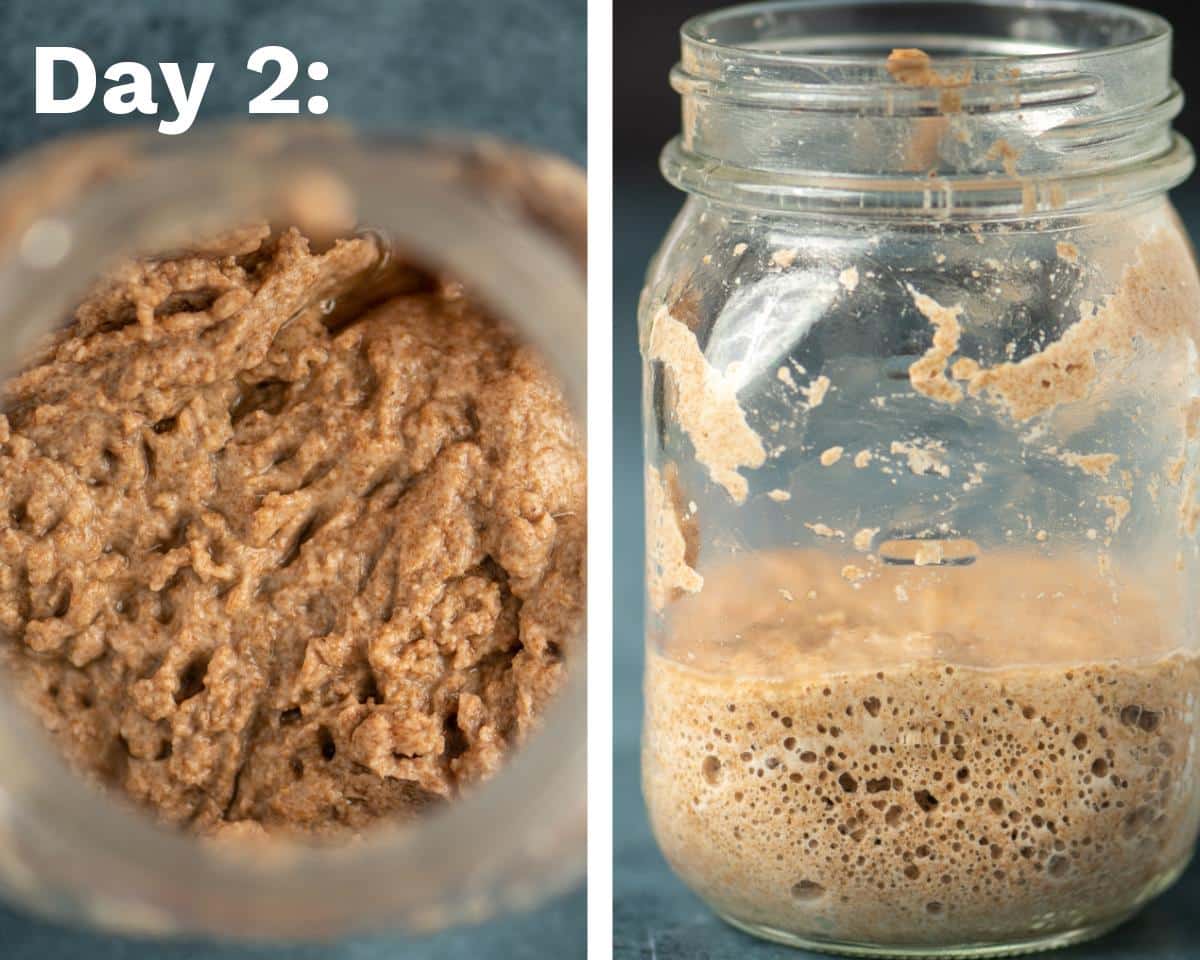
Day 3.
- This is the first day you’ll feed the starter. Feed it no matter what it looks like. At this point the starter is going to be “stretchy”.
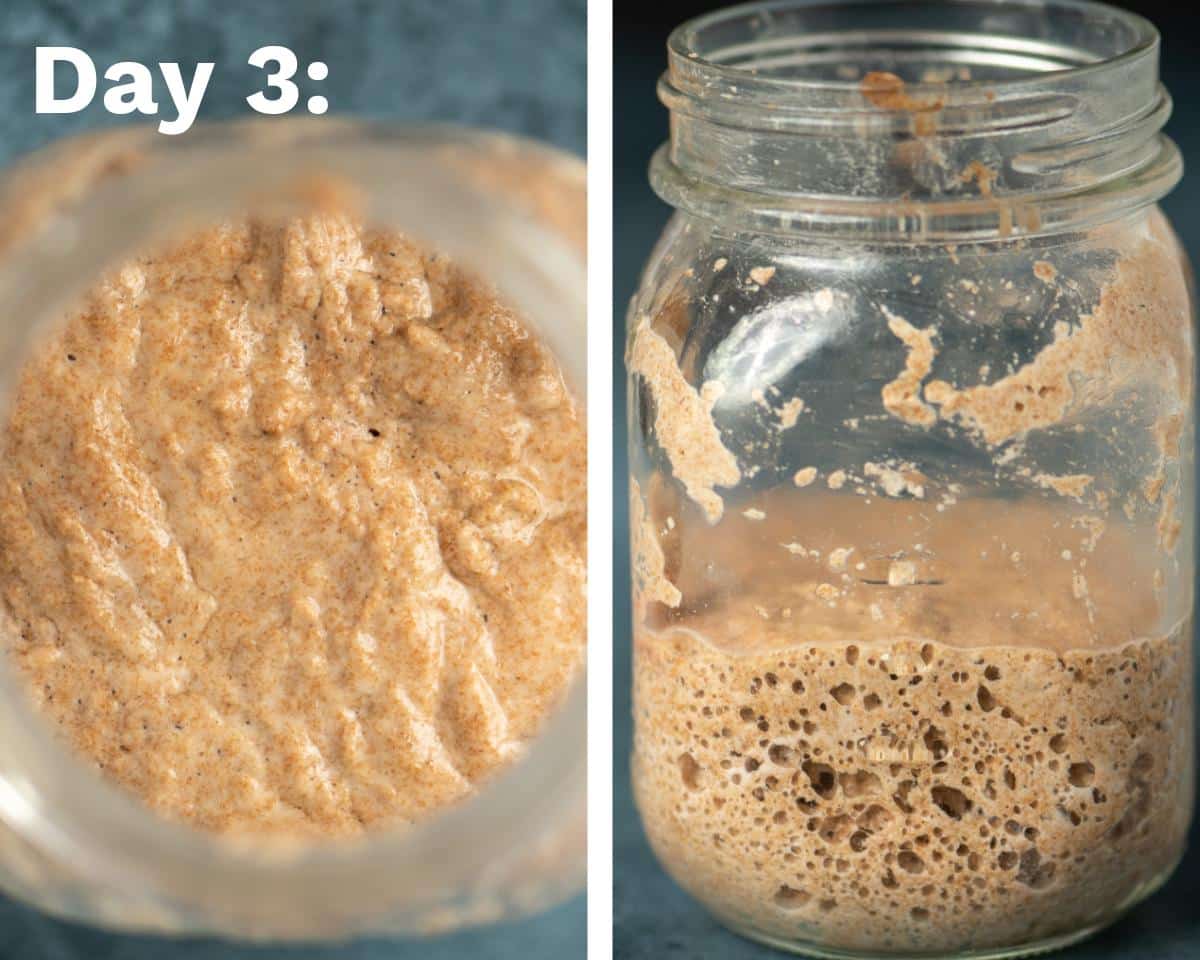
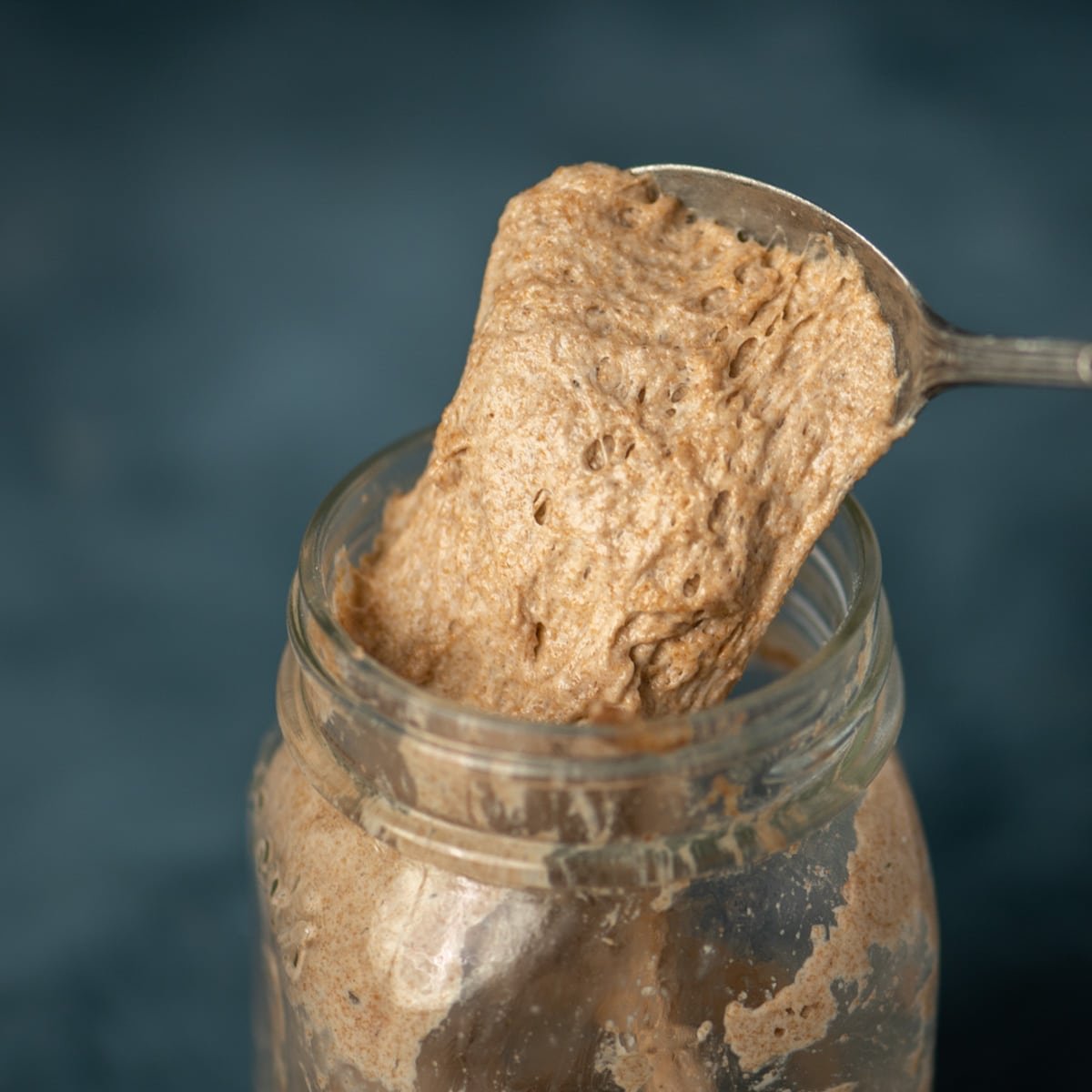
- Pull out half of the starter and throw it away. Use your kitchen scale to again add 60 grams of all purpose, white, unbleached flour (remember…you only use whole wheat that first day) and 60 grams of warm water to the remaining starter. Always use equal parts flour and water.
- Mix it all together. It will still be really thick. Cover loosely with plastic wrap.
Day 4, 5, and 6.
- Discard half of the starter and feed as you did in Day 3. You’ll do the same thing each day no matter what the starter looks like. Discard half, and feed with equal amounts of flour and warm water.
- As these three days pass you’ll notice a natural rise and fall to the starter. This is an important process to observe because it will help you learn you when the starter is ready to bake with and when it is hungry. You can use a rubber band (or a piece of tape) on the jar to mark where the starter is when you feed it, then how it doubles as the starter grows.
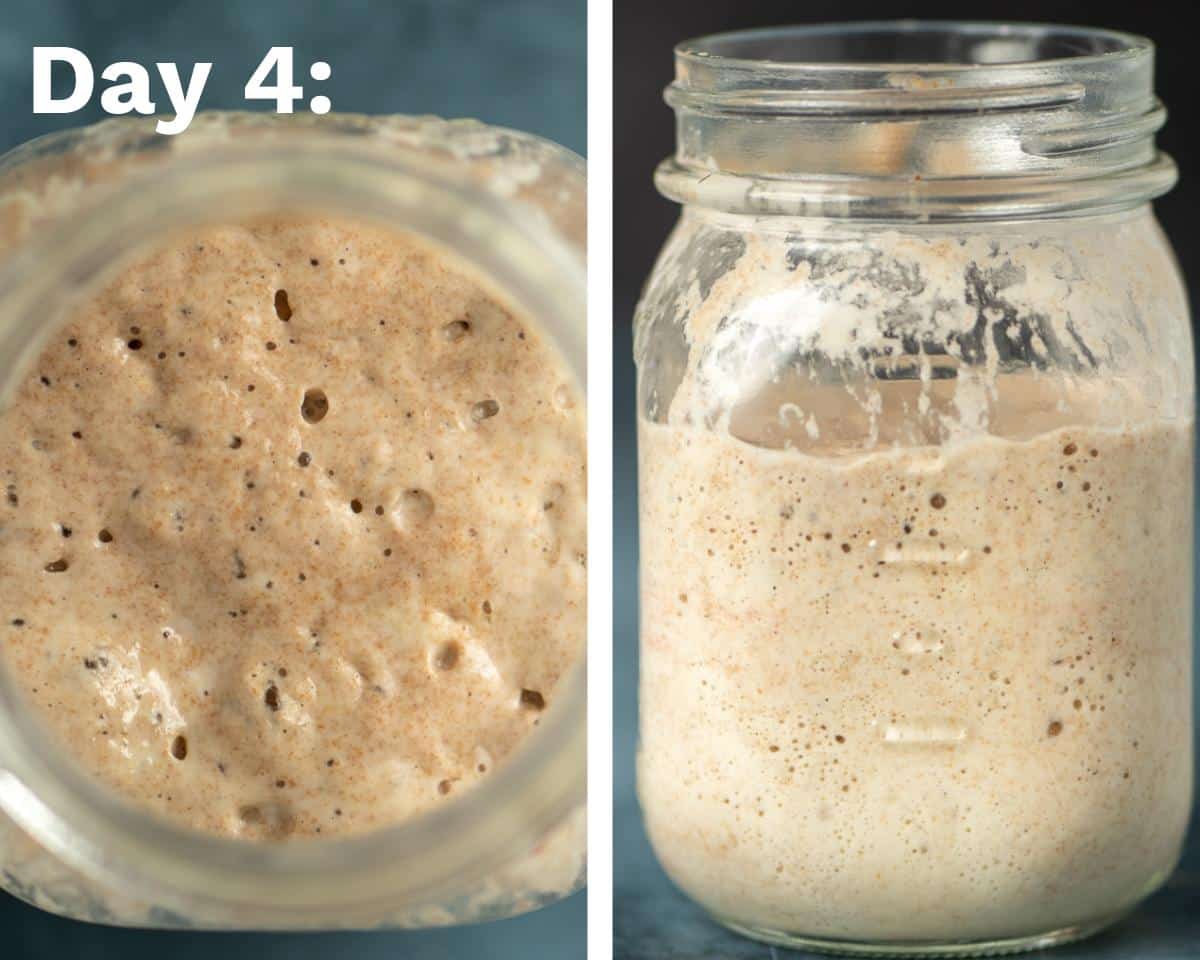
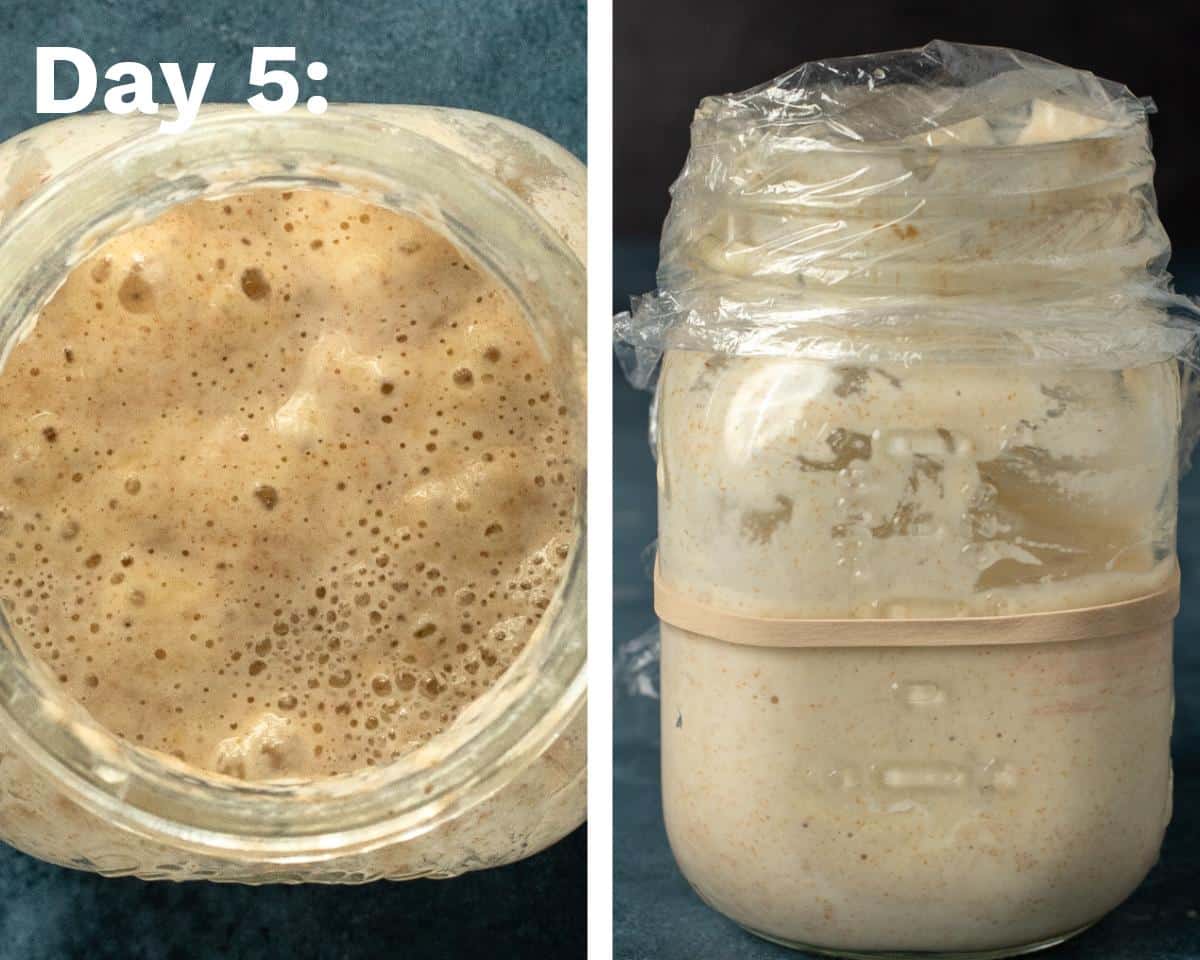
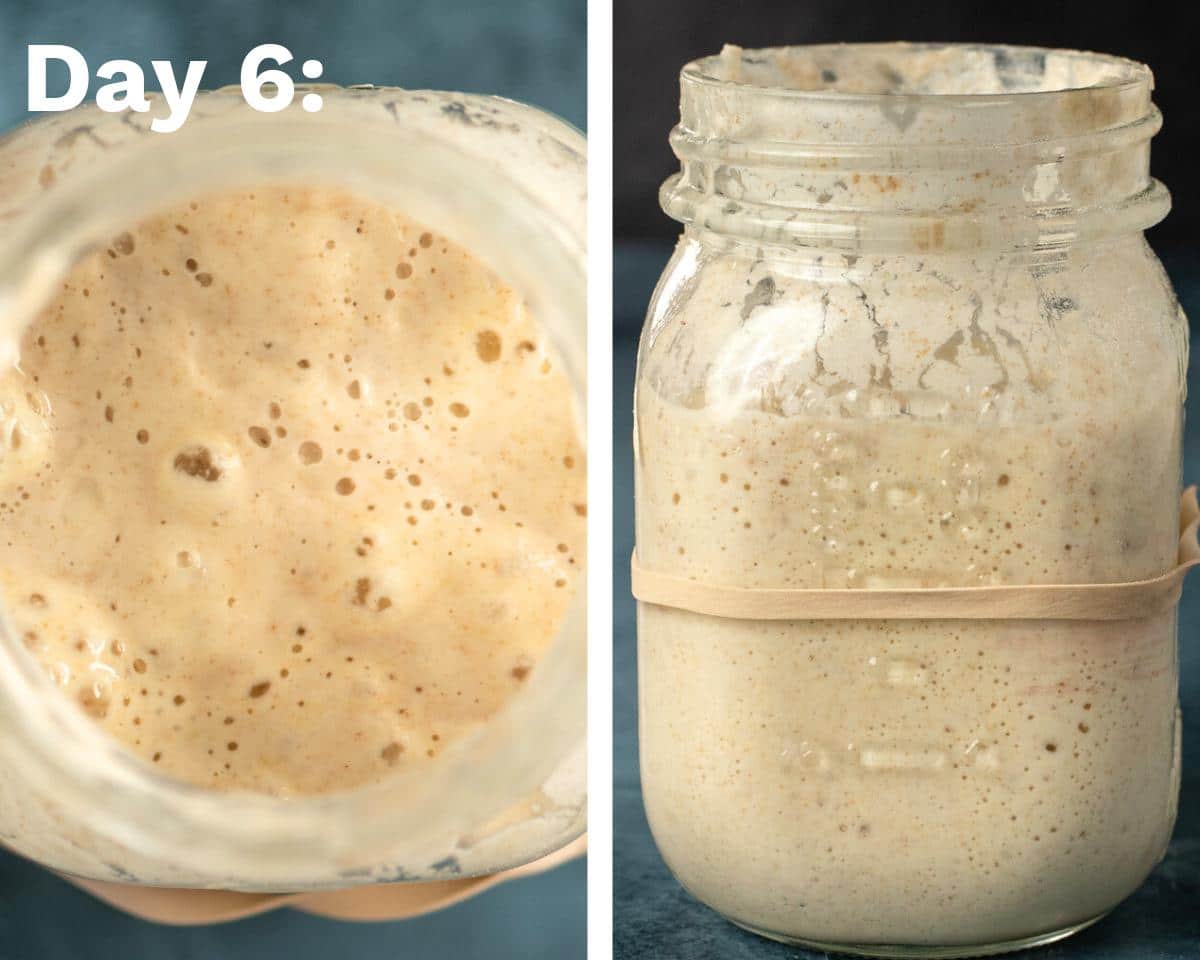
Day 7.
- Your new starter should have lots of bubbles and you are almost ready to bake! A healthy starter should look light and airy and have a sweet and tangy aroma. It should not be a sharp or harsh smell.
- When your starter looks like this, it means it is ready to start baking the baking process!

- If your starter does not look like this, you might want to continue the feeding process for a few more days before using it. This can happen often in cooler temperatures.
When is starter ready to bake with?
Starter is ready when it is bubbly and in the “doubled” stage. This is called an “active sourdough starter”. If you are wanting to bake bread and the starter is “deflated”, feed the starter, wait a couple of hours and it should be doubled and ready to bake with.
TRY THE FLOAT TEST
Drop a little bit of starter into a glass jar. If the starter floats, it is ready to bake with. See the picture below.
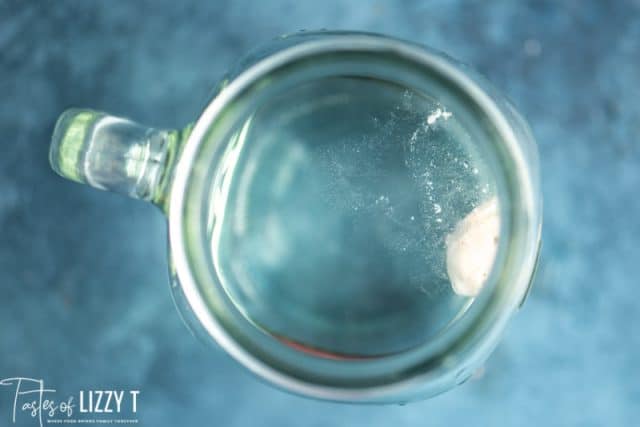
And for fun…name your starter!
Once you have your homemade sourdough starter it’s time to name it! We named ours Clint. You know…for “Clint Yeastwood”. 🙂 Have fun with it!
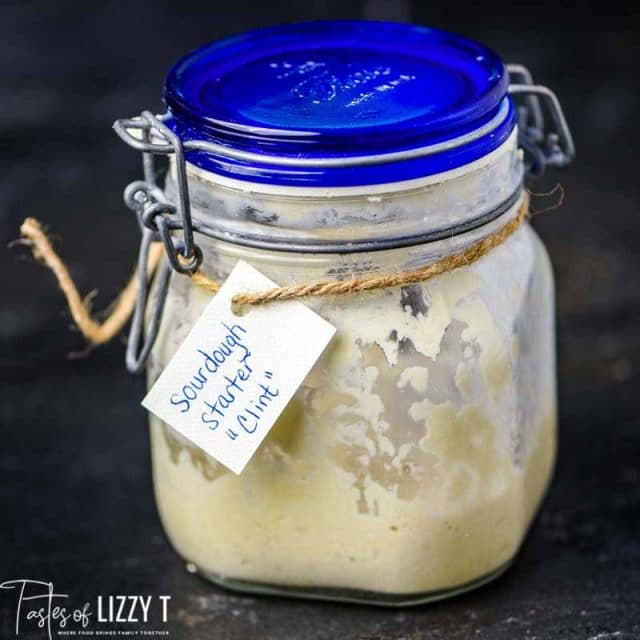
Feeding Schedule
- If you are storing your starter at room temperature, you’ll need to feed it daily. Depending on how much you keep, you can discard about half the starter (use it in sourdough pancakes) and feed it equal amounts of the unbleached all-purpose flour and non-chlorinated water.
- If you don’t use your sourdough often, seal it and store it in the refrigerator. Feed it weekly with equal amounts of flour and water. There will be a cloudy liquid on top of the starter. That is called “hooch” and it means your starter is hungry. Stir that liquid in, then feed. Do this weekly. I like to set a reminder on my phone to go off once a week. That way I always have starter on hand.
- Once your sourdough is refrigerated, be sure to remove it from the fridge 12-24 hours before you are ready to bake. Mix it, feed it, then watch for it to bubble. If it doesn’t bubble, discard half of the starter and feed again with equal amounts of water and flour.
You’ll learn the timing of your own starter and know how long it takes to get it bubbly and active after a few times.
What should I make with my new starter?
First, make a beautiful loaf of artisan sourdough bread! There’s just nothing like it. Then you can try sourdough cinnamon rolls. Because you know we’re all about the homemade cinnamon rolls. 😍
How much starter should I keep?
Replenish your starter after you’ve used some up by adding 25 to 50 grams of flour and an equal weight of water to keep at least ¼ cup of starter.
If you have an active starter, it’s so easy to quickly grow more sourdough if you’re needing a large amount. There is no need to keep huge amount of it in your refrigerator.
And that’s about it! Please share your hints for making sourdough. What have you had success with? I know many of you are pros and can help me along my sourdough journey!
What do I do with the daily discards?
Discard recipes use a leavening agent (baking powder, baking soda or yeast) to get a rise in the baked good. See some of our favorite recipes using sourdough discard here:
- sourdough discard pancakes
- sourdough discard pizza dough
- sourdough bread with yeast
- sourdough biscuits
- sourdough rolls
- whole wheat sourdough pancakes
- pumpkin sourdough bread
- sourdough pie crust
Books to Help You Learn
- Artisan Sourdough Made Simple. This cookbook was a lifesaver for us!
- Starter Sourdough. The step by step guide
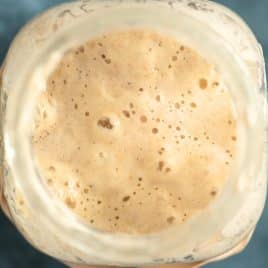

How to Make Sourdough Starter
If you've ever wondered how to make sourdough starter without yeast, this is your complete guide! Traditional 7 day sourdough starter with perfect results, every time. It's an easy recipe that takes just 5 minutes a day.
Prep Time 20 minutes
Resting Time 7 days
Total Time 5 minutes
Equipment
- Sourdough Jar
Ingredients
- 60 grams unbleached whole wheat flour
- 300 grams warm non-chlorinated water (divided)
- 360 grams all-purpose unbleached flour (divided)
Instructions
Day 1.
- Start with a clean glass jar. I use a pint size mason jar when I am beginning a starter, but a weck jar or other glass jar will be fine too. You’ll just want it to be able to hold about 2 cups so that it can handle the rise of the starter.
- Place the jar on the kitchen scale. Turn the scale on and make sure it is reading 0 grams. If it isn’t, press the “tare” button to get the display to read zero.
- Add 60 grams of whole wheat flour and 60 grams of warm, non-chlorinated water. The mixture will be very, very think. It won’t be impressive at all to start.
- Cover the jar loosely with plastic wrap and let it sit at room temperature, of in a spot where the room temperature is slightly warmer.
Day 2.
- Check the starter. You’re looking for bubbles to form. If you don’t see any, it is ok because they come and go fairly quickly. Don’t mix it. Just check it, then let it sit again for another 24 hours.
Day 3.
- This is the first day you’ll feed the starter. Feed it no matter what it looks like. At this point the starter is going to be “stretchy”. Pull out half of the starter and throw it away. Use your kitchen scale to again add 60 grams of all-purpose unbleached flour and 60 grams of warm water.
- Mix it all together. It will still be really thick. Cover loosely with plastic wrap.
Day 4, 5, and 6.
- Discard half of the starter and feed as you did in Day 3. You’ll do the same thing each day no matter what the starter looks like. Discard half, and feed with equal amounts of flour and warm water.
- As these three days pass you’ll notice a natural rise and fall to the starter. This is an important process to observe because it will tell you when the starter is ready to bake with and when it is hungry. You can use a rubber band (or a piece of tape) on the jar to mark where the starter is when you feed it, then how it doubles as the starter grows.
Day 7.
- Your starter should be very bubbly and you are almost ready to bake! It should have a sweet and tangy aroma. It should not be a sharp or harsh smell. It should look light and airy.
- If your starter does not look like this, continue the feeding process for a few more days before using it.
- Once your starter is light and airy, it's time to bake with it! Place the active starter in a clean jar that it will continue to live in as you feed it.
- Click here to make our favorite artisan sourdough bread recipe.
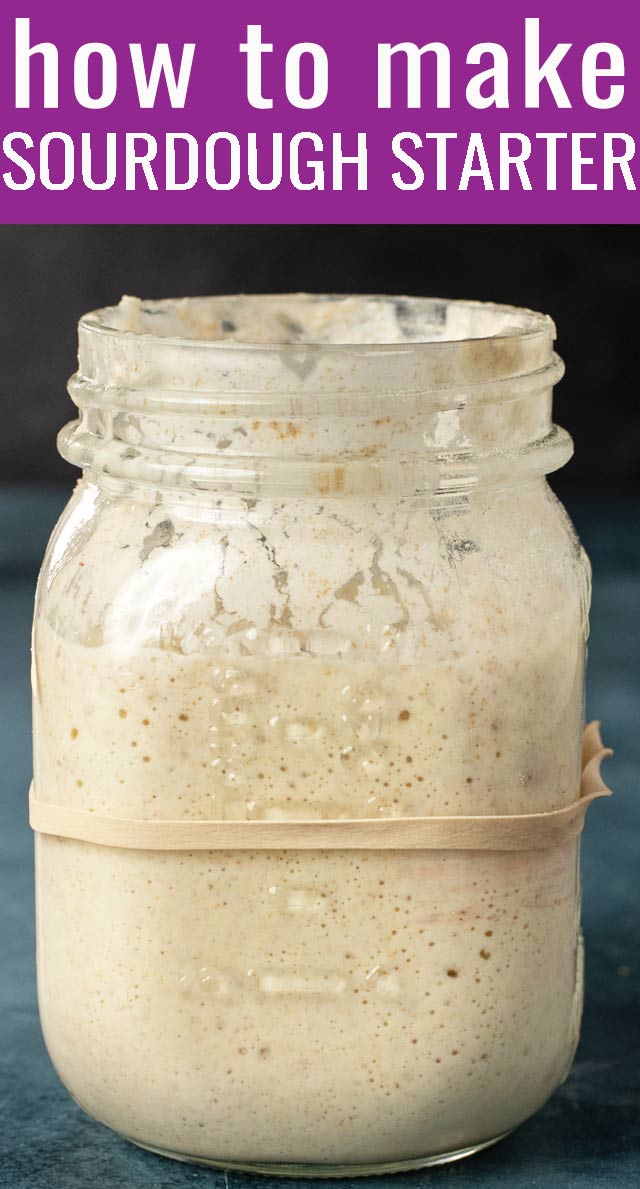
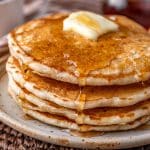


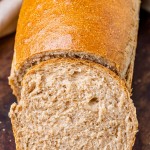
I don’t ha e a scale. I read that 60g of flour is 1/2 cup and 60g of water is 1/4 cup. Is that right?
Thank you for this. According to the recipe, I would need 360 gr of white un bleached APF (divided by 6=6) and 300 gr of water(divided by 60 =5). It seems by day 7, I would have 120 gr of flour left if I’m following the instructions of adding equal amounts of flour and water on days 3,4,5,6. I’m a little confused. Also if I’m ready to bake on day 7, following your time schedule according to the Artisan sourdough bread recipe, at 3 pm I would feed the starter. Would I be removing half of starter and adding 60… Read more »
Can I use white whole wheat flour? That’s all I have and my grocery store is very low on All flours.
I grind my own wheat and use hard red wheat. Is this something that is going to kill my starter or help it grow? I got a starter from someone else and stumbled upon all of your info.
I made the starter, now I have a question about discard. I am keeping mine in the refrigerator. I have fed it once a week, with a cup of water and a cup of flour. Do I discard half of my starter every time I feed it? Where does the discard come from I guess is what I am asking. And do I just scoop out of my starter when I go to make recipes? Like the rolls on your site?
Thanks so much!
I have been trying to make sour dough starter for about a month now and had to discarded all of it. Ugh! So I am going to try again. This is the first I have read about using unbleached flour and filtered water. It makes perfect sense so here I go again 🙂
When you say discard “half” how exactly do I determine how much is half?
I’m on day 11 with my starter and at the moment it has lots of bubbles, but doesn’t rise much at all. The only time it doubled was day 3 and 4. After that, not much….plus the consistency is very wet.
I’ve been using a combination of whole wheat and all purpose about 1:3 ratio now and filtered water.
So the main concern I have is the runny consistency and that it hasn’t doubled since early days….
Thoughts?
What is the purpose of throwing away some of the starter after day 3 and days after? I don’t like to be wasteful.
Should I stir the starte first and then discard half of it?
I went to culinary school after I got my B.S. in Hospitality Management. I went the culinary arts route vs. the baking & pastry arts route. So baking hasn’t been something I’ve done a whole lot of with the exception of cookies, cupcakes, carrot cake & flourless chocolate cake. Sourdough bread is a whole new game for me. My husband has been put on a low FODMAP diet by his gastroenterologist to help mitigate his symptoms. His dietician from his care plan has said if he is going to have bread it needs to be sourdough. Your blog was the… Read more »
How to make it extra sour? As I love the really sour sourdough breads as well as pancakes.
Thanks!
I am on day 10 of the starter and it has not risen at all; I can see little bubbles on the top. I have followed the recipe and am weighing everything on a kitchen scale. I was leaving the jar on my kitchen counter but tried the oven with the light on for the past two days–no difference. Should I give up? Can I add some yeast to it to give it a kick start?
My starter is bubbling already its the 3rd day, i just fed it with flour and water at 7am and its doubled risen and bubbly !!!what should I do ?just keep going on till day 7? Im afraid it will die ..
Hi. I am on day 10 of the starter and it just isn’t rising or bubbling. I smells nice and doesn’t look bad but is just a thick paste with watery liquid on top. I am keeping it warm and feeding but it just isn’t looking right. Do I start again? Or can I kick start it with some yeast!? Any help appreciated.
This is great! I’ve read so many different things on so many different blogs. This one just clicks. Question for you: When my started was given to my by a friend she told me to just add 50g flour and 50g water twice a day, 8-12 hours a apart but didn’t say to discard any…so of course that quickly started to grow like crazy and I started discarding…then started doing my own research because I figured the info she gave me was incorrect. I’ve also read it should be 1 part starter, 1 part flour and 1 part water. All… Read more »
I was looking for someone with the traditional method. Glad to find it. I did it several years back but didn’t eat enough bread to make it worth it so I stopped. Couldn’t remember everything now though. San Francisco style uses a little milk in the starter on first step. It amazes me how much people rely on Yeast and find sourdough hard to do since commercial yeast was only invented in the 1890’s or so if I remember the history right. The passover bread of the Bible was unleavened because they did not have the time to make it… Read more »